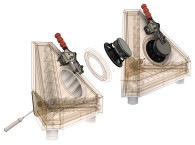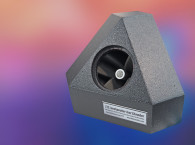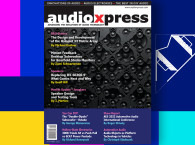
As a general rule when you are making one-offs, precision and repeatability is not or should I say was not as highly regarded then as it is now. And that is the link between standards and calibration. In order to calibrate something, you have to have adequately defined Standards, so when you measure it, you can refine the measurements defining measurement uncertainties.
Calibration Systems - Links to Metrology
Arguably some of the first defining characteristics of civilization are those of (1) Record keeping and (2) Measurement. It’s difficult to imagine one without the other so in all probability they both emerged together.
When you have a measurement, you need at some point to deal with uncertainty. As a simple example, it is easy to count 10 coins, but what about counting grains of rice? You can count 10 individual grains but what about the number of grains of rice in a bag? A barn or a silo of grain? Taking another physical example, a length of a beam? The distance between aircraft in the sky? Inherently there will be some uncertainty of these (if only because they are moving) but how much and how can we define it so that we can have confidence in our measurements?
Even within “simple” measurements uncertainty can quickly overcome/exceed the measurement tolerance for many reasons, often these come down to the measurement environment. The science of this is called Metrology and was defined by the International Bureau of Weights and Measures (BIPM, 2004) as “the science of measurement, embracing both experimental and theoretical determinations at any level of uncertainty in any field of science and technology.” I believe the key words here are “Determination of Uncertainty.” We don’t know and can’t know a measurement value absolutely only within a tolerance of that value.
And how do we make reliable, consistent, and accurate measurements? The obvious thing is first to determine why a measurement may suffer from variation(s) and then to strive to eliminate as many of these cause(s) as possible. We then need to consider how accurate we need to be. This largely depends upon the individual usage of a measurement. With loudspeakers, it probably does not matter much if the sensitivity of a speaker is off by 0.1dB, however if we were calculating a trajectory for a spacecraft, we would need a much higher degree of certainty in our measurements.
So how do we guarantee any measurement? The first thing to say is that there is no such thing as an absolutely accurate measurement—only one that is known to a degree of uncertainty. The primary standards are known to a higher degree of accuracy and have a smaller range of uncertainty. A “Hierarchy of Standards” is defined as:
- Primary standards
- Secondary reference standards
- Working standards
- Laboratory standards
Primary standards are held in only a very few selected locations and organizations throughout the world—these are the internationally agreed standards and are held by the International Bureau of Weights and Measures, which is an intergovernmental organization through which its 59 member-states act together on measurement standards. An example was the standard meter, an example of which is shown in Photo 1. This is now defined as 1/299 792 458 of the speed of light...

A continuing trend in metrology is to eliminate as many as possible of the artifact standards and instead define practical units of measure in terms of fundamental physical constants, as demonstrated by standardized techniques. One advantage of elimination of an artifact standard is that inter-comparison of artifacts is no longer required. Another advantage is that the loss or damage of an artifact standard will not disrupt the system of measures. Secondary reference standards are held by individual countries primary calibration organizations (e.g., NPL in the UK and NIST in the US).
Finally, working standards are held by calibration labs usually commercial or academic institutions that reference the national standards organization to calibrate their standards. Individual instrument companies thus refer for their calibration upon these working calibration standards. Thus in theory and practice an unbroken calibration chain can be realized, the point to note that at every stage there is a measurement uncertainty and one of the prime aims of metrology is to determine this, and of course we want to minimize any such uncertainty at every stage.
Sound Standards
Sound pressure level (SPL) is the pressure level of a sound, measured in decibels (dB). It is equal to 20x the Log10 of the ratio of the Root Mean Square (RMS) of sound pressure to the reference of sound pressure (the reference sound pressure in air is 2 x 10-5N/m2, or 0.00002Pa). The primary requirement to calculate SPL relies upon N=Newtons a measure of Force, m2,or m2 = distance and area. This is referenced to the nominal threshold of human hearing at 1kHz taken to be 0dB SPL or 20µPa.
In high volume applications — be that automotive, mobile, telecom, or consumer products — it is essential that designs are safe and compatible between competing products, and also that the same item is being made in the same way every time. That is where standards and in particular international standards come in.
Standards and Standards Organizations, enable people from individual companies to contribute freely to the common good — so a standard, represents a balanced consensual agreement by experts in that subject and the best implementation at a given time.
A standard clearly outlines the overall results that can be expected by following a general outline of a methodology, so they, like patents — which by granting a time-limited monopoly in return for the open disclosure of an idea can gain protection — refer to earlier inventions and techniques.
A natural result of this is that standards need to evolve and they enable any discipline to continually update itself to current best practice. As an example, individual authors publish books or issue papers about Loudspeakers through journals in our field of interest, by the American Acoustical Society (ASA), Audio Engineering Society (AES), and the Institute of Acoustics. However these books and papers have not and cannot have been fully peer reviewed, while the process of publication as a standard requires a full peer review together with a public call for comment. This ensures that a standard can be relied upon to achieve what it sets out to do and importantly that the underlying science is correct.
I first came to Loudspeaker Standards around 1980, via IEC60268-5 (which was first issued in 1972). By 2003, the Total Q-factor (Qt) Thiele-Small parameters and the compliance of a loudspeaker drive unit had been defined along with the basic measurement setup of an anechoic chamber, the IEC baffle, and various test boxes, together with harmonic distortion, noise signals, and so forth.
The Abstract of the first edition summarizes it as: “Applies to sound system loudspeakers, treated as entirely passive elements. Gives the characteristics to be specified and the relevant methods of measurement for loudspeakers using sinusoidal or specified noise signals.”
To better understand it, let us briefly look at the contents of IEC60268-5:2003, which is the last major incarnation.
We had just four signals defined: Sine, Broadband and Narrow band noise, and Impulsive. The measurement environment was characterized as free-field and half space, diffuse, and simulated free-field, and the document specifies standard baffle or enclosures, impedance measurement, total Q-factor (Qt), Vas, rated voltage (Power), frequency range, and sensitivity, radiation angle and directivity index, amplitude nonlinearity, THD, and stray magnetic fields.
However, the loudspeaker theory and practice in 2021 is much more advanced compared to the 2000—let alone the 1980s! And a major update was arguably overdue to make those standards applicable to all kinds of modern audio devices whether active or passive.
There’s also the need to cope with any input signal, analog, digital, wireless, or something new to include new measurement techniques (e.g., Rub & Buzz test); and to bring together manufacturing (QC) and system development (R&D).
Updates were also required to provide comprehensive information in a shorter measurement time, simplify interpretation (e.g., root cause analysis), and to increase flexibility to consider particularities of the applications (e.g., home, automotive, personal, and professional).
These new considerations are approached in the updated standards:
- IEC 60268-21: Output Based Acoustical Measurements
- IEC 60268-22: Electrical and Mechanical Measurements on Transducers
- IEC 63034: Micro-speakers
These multiple standards are necessary as increased use of loudspeakers in many areas show a single standard is no longer enough.
Acoustical (Output Based) Measurements
The scope of the IEC 60268-21:2018 International Standard applies to passive and active sound systems, such as loudspeakers, headphones, TV sets, multimedia devices, personal portable audio devices, automotive sound systems, and professional equipment. It applies to those loudspeakers that are best described as “Black Boxes” in that they accept an input—analog, digital, radio, or something else—and then produce an acoustic output. It is this acoustic output which is the subject of the standard.
The evaluation of the Output is of course dependent upon the Black Box (Figure 1).

Where A Black Box is used as description of a system whose internal workings are (1) Unknown or (2) the internal status at any time is unknown, all that is known are the inputs and the overall output. As in previous standards, measurements can be made in the near field or the far field.
The outputs of concern are generally those that a user will directly notice: amplitude (SPL) versus frequency (Hz) and distortion (% or dB), together with maximum level.
The key is that specifications and measurements made under this standard are relevant user output-based ones. The users have no knowledge of the internal workings of the system. The specifications therefore are purely input to output based, or ones that rely only upon measurable acoustic outputs such as:
- SPL vs. Frequency
- THD vs. Frequency
- Output level vs. Distortion
So, IEC 60268-21:2018 is primarily focused on output-based measurements. It updates the measurement techniques to include stimuli (chirp, multi-tone complex, and burst), includes comprehensive physical evaluation of the acoustical output, and assesses large signal performance (considering heating and nonlinearities). Umax or SPLmax are rated by the manufacturer to calibrate the Real Mean Square (RMS) value of the stimuli.
The updated standard also extends acoustical measurements of loudspeaker beyond the IEC baffle to include relative and end-of-line test chambers based upon the tetrahedral test method, and considers a complete assessment of the 3D sound field radiated by the loudspeaker in an anechoic environment (near and far field).
It also describes physical measurement of higher-order harmonics and impulsive distortion in the time domain to assess Rub & Buzz and other loudspeaker defects. It effectively forms a bridge between manufacturing (QC) and research and development (R&D) measurement procedures.
Maximum Input and Output Signal
These measurements are required to allow effective measurements of both conventional passive and more commonly of active loudspeaker systems (Figure 2). However, to make such measurements we need to firstly define and calibrate our input signals. The updated standard considers new sinusoidal chirp, steady-state two-tone signal, sparse multi-tone complex, and Hann-burst as input signals for that effect.

Such signals can be applied through the appropriate methodology, be that analog, digital, or any other suitable means compatible with the device under test, which give us the possibilities of applying new measurements such as adjustment of input levels, compression, and delay, impulsive and multitone distortion (Figures 3–5).
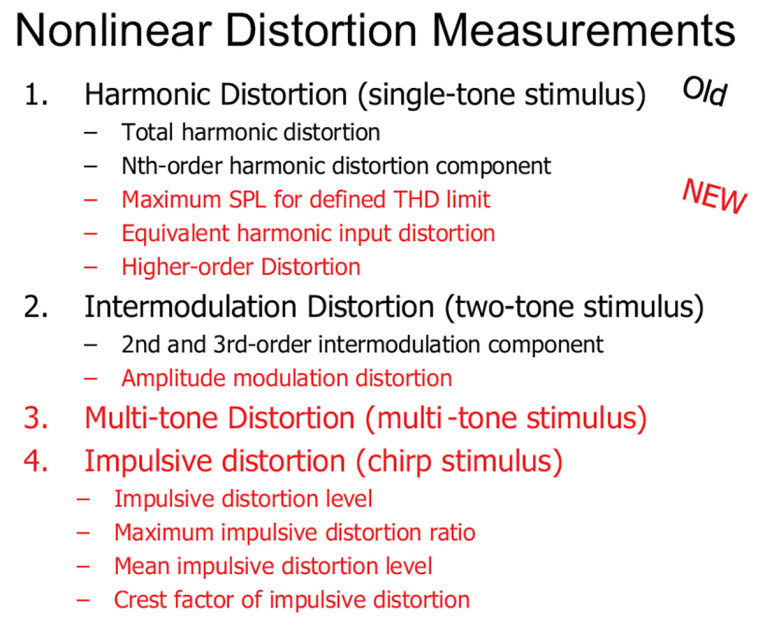
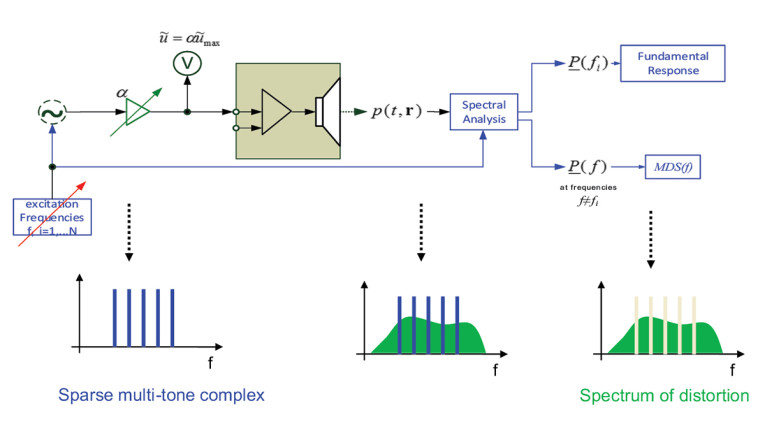

Next Month
In Part 2, we discuss how these new standards apply to measurements of sound in 3D space and in production environments, measurement of SPL using voltage sensitivity, and the measurements of microspeakers. aX
Read Part 2 of this article here
Resources
W. Klippel, “Electrical and Mechanical Measurements of Loudspeakers and Sound System Equipment: Tutorial to a New IEC Standard,” 2016, www.klippel.de.
“Meter,” National Institute of Standards and Technology, updated June 2021, www.nist.gov/si-redefinition/meter
“What is Metrology,” NCSL International, https://ncsli.org/page/WIM
This article was originally published in audioXpress, September 2022.
 About the Author
About the AuthorGeoff Hill, inventor of the Tetrahedral Test Chamber (TTC) and CTO at Hill Acoustics, has been working in the loudspeaker and audio industry for more than 40 years. He is Chair of the AES SC-04-03 Working Group on loudspeaker modeling and measurement and a member on the IEC Working Group TC 100/TA 20/PT 60268-22. He is also the author of Loudspeaker Modelling: A Practical Introduction. Geoff welcomes your comments and can be contacted via email.



